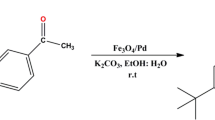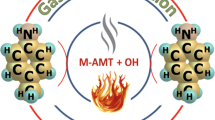Abstract
Both π and σ transition states on the potential energy surface of the nitration of benzene with nitronium ion have been successfully optimized using unrestricted hybrid DFT procedure B3LYP with the triple-zeta 6-311G ** basis set without any assumption. Subsequently, a σreactant-complex and a σ intermediate (Wheland intermediate) were located by the intrinsic reaction coordinate (IRC) calculation. The reaction pathway and the experimental observation lacking the kinetic isotopic effect in the title nitration were confirmed on geometries, atomic charges, energies, IR spectra and thermodynamic properties of all stationary points. The activation energy of 8.370 kJ/mol in the gas phase and the order of 1010 mol η L-1 η s-1 of rate constant were obtained for the reaction. The results both in thermodynamics and kinetics show that the electrophilic substitute mechanism is more preferable than the electron transfer mechanism of radical pairs. The solvent effect on the geometries of stationary points and the reaction mechanism were systematically studied for the nitration of benzene with nitronium by self-consistent reaction field (SCRF) technique with different dielectric constants of 5.0, 25.0, 50.0 and 78.5. It was then found that the solvent effect would depress the activation energy and finally make the formation of σ-TS without energy barrier in aqueous solution. Furthermore, the linear correlations given by charge migrations of NO2 group, dipole moments of solute, gaps of HOMO and LUMO and solvent stabilization energies in different solvents were demonstrated for both theoretically and experimentally concerned Wheland intermediate.
Similar content being viewed by others
References
Perrin, C. L., Necessity of electron transfer and a radical pair in the nitration of reactive aromatics, J. Am. Chem. Soc., 1977, 99: 5516–5518.
Eberson, L., Hartshorn, M. P., Radner, F., Ingold’s nitration mechanism lives, Acta Chem. Scand., 1994, 48: 937–950.
Schofield, K., Aromatic Nitration, London, New York: Cambridge Univ. Press, 1980.
Politzer, P., Jayasuriya, K., Sjoberg, P. et al., Properties of some possible intermediate stages in the nitration of benzene and toluene, J. Am. Chem. Soc., 1985, 107: 1174–1177.
Gleghorn, J. T., Torossian, G. (in part), Theoretical study of the enthylene and benzene with the nitronium ion, J. Chem. Soc. Perkin Trans., II, 1987: 1303–1310.
Szabo, K. J., Hornfeldt, A. -B., Gronowitz, S., Theoretical study on mechanism and selectivity of electrophilic aromatic nitration, J. Am. Chem. Soc., 1992, 114: 6827–6834.
Melander, L., Saunders, W. H. Jr., Reactions Rates of Isotopic Molecules, New York: John Wiley and Sons, 1980.
Wheland, G. W., A quantum mechanism investigation of the orientation of substituents in aromatic molecules, J. Am. Chem. Soc., 1942, 64: 900–909.
Harmond, G. S., A correlation of reaction rates, J. Am. Chem. Soc., 1955, 77: 334–338.
Weast, R. C., Handbook of Chemistry and Physics, 55th ed., Cleveland: CRC Press, 1974.
Xiao, H. M., The Molecular Orbital Theory for Nitro Compounds, Beijing: National Defense Industry Press, 1993.
Xiao, H. M., Chen, Z. X., The Modern Theory for Tetrazol Chemistry, Beijing: Science Press, 2000.
Zhang, J., Xiao, H. M., Gong, X. D., Theoretical studies on heats of formation for polynitrocubanes using the density functional theory B3LYP methods and semiempirical MO methods, J. Phys. Org. Chem., 2001, 14: 583–588.
Li, J. S., Xiao, H. M., Dong, H. S., A theoretical study on the intermolecular interaction of energetic system— Nitromethane dimmer, Chin. J. Chem., 2000, 18(6): 815–819.
Zhang, J., Xiao, H. M., Computational studies on the infrared vibrational spectra, thermodynamic properties, detonation properties, and pyrolysis mechanism of octanitrocubane, J. Chem. Phys., 2002, 116: 10674–11683.
Seminario, J. M., Politzer, P., Modern Density Functional Theory: A Tool for Chemistry, Amsterdam: Elsevier, 1995.
Frisch, M. J., Trucks, G. W., Schlegel, H. B., et al., Gaussian 98w on-line help.
Wong, M. W., Frisch, M. J., Wiberg, K. B., Solvent effects, 1. The mediation of electrostatic effects by solvents, J. Am. Chem. Soc., 1991, 13: 4776–4791.
Li, X. Y., He, F. C., Electron transfer NO +2 +NO→NO2+NO+ in aromatic nitration, Science in China, Series B, 1997, 40(5): 523–528.
Mu, T. C., Zhou, L. Z., Calculation reorganization energy of electron transfer reaction in benzene nitride, Chin. J. Chem. Phys., 2002, 15(5): 363–366.
Scott, P., Radom, L., Harmonic vibrational frequencies: An evaluation of Hartree-Fock, moller-plesset, quadratic configuration, density functional theory and semiempirical scale factor, J. Phys. Chem., 1996, 100: 16502–16513.
Author information
Authors and Affiliations
Corresponding author
Rights and permissions
About this article
Cite this article
Xiao, H., Chen, L., Ju, X. et al. A theoretical study on nitration mechanism of benzene and solvent effects. Sc. China Ser. B-Chem. 46, 453–464 (2003). https://doi.org/10.1360/02yb0215
Received:
Issue Date:
DOI: https://doi.org/10.1360/02yb0215




